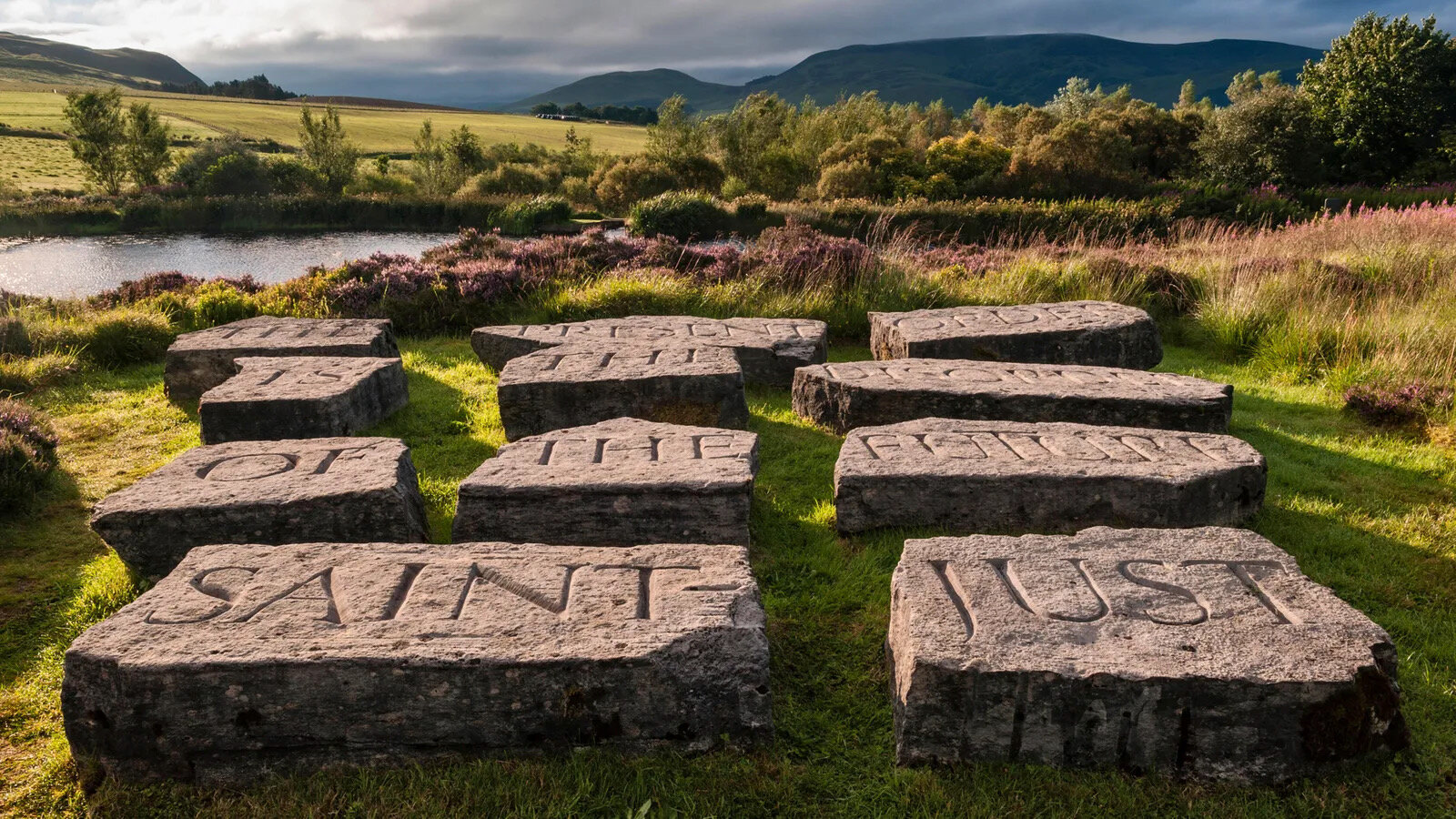Culture
Some of the best outdoor art and photography to see now
(Image credit: Donna Travis)
From a Norwegian sculpture park to a London street and a hidden Scottish gem, alfresco art is increasingly popular. Andrew Dickson explores why, in the open air, art comes alive.
In these pandemic-stricken January days, bright spots are hard to find. Particularly if you're the type who generally gets through the winter by booking as much theatre as possible, making plentiful cinema dates, scouting out new bars and restaurants, and seeing every art show in the calendar. The museum and gallery closures seem especially cruel: although institutions around the world have done everything possible to become Covid-secure, many have been closed for several months at a time. Some haven't reopened since last March.
However, some art spaces are experiencing a resurgence – ones that don't have walls or roofs. Whereas indoor exhibition teams have had to work around ever-changing sanitation, social distancing, infection tracking and ventilation regulations – or simply last-minute closures – in the open air things are infinitely freer. Just as parks or the countryside have become the only way for millions to socialise during the pandemic, sculpture gardens, arboretums and outdoor galleries have been the places many of us feel comfortable seeing art.
Rainbow Reflection by H de Klerk is one of the photographs featured in the recent outdoor exhibition, Hold Still (Credit: NPG/ H de Klerk)
Whether it's community-led, pop-up installations in cities, repurposed riverside walks or major museums taking over advertising hoardings – as Britain's National Portrait Gallery did recently with its pandemic-themed group photography show Hold Still – there has been an exciting sense of experimentation in the art world. Historic sculpture gardens in Japan have welcomed new visitors; artists in Kigali, Rwanda, have been creating murals to promote anti-coronavirus health messages; and a political work by Nick Cave is to be reinstalled on the front of the Brooklyn Museum. Might this be the time that we start to appreciate the power of open-air culture, even in the middle of winter?
One man who certainly believes more of us need to brave the elements is Jarle Strømodden – who, admittedly, has skin in the game. As director of the Gustav Vigeland Museum in Oslo, he's not only responsible for Vigeland's former apartment and studio, occupied by the sculptor from 1924 until his death in 1943, but a huge sculpture park on the edges of the city, one of the city's signature attractions.
The Monolith Plateau is a symbol for Norwegians, and is the centrepiece of the Vigeland sculpture park in Oslo (Credit: Alamy)
More than 80 acres in size, the park holds over 200 of Vigeland's monumental sculptures, making it perhaps the world's largest installation devoted to the work of a single artist. "There is nowhere entirely like it, I think," Strømodden says when we talk over Zoom one dark winter afternoon. Located in Frogner Park, the sprawling grounds of a former manor, the Vigelandslegget became a life's obsession for the artist, who by the 1920s was Norway's most renowned sculptor (internationally, he is largely known for designing the surprisingly rugged-looking medal for the Nobel Peace Prize). Invited to design a fountain by the city authorities, Vigeland agreed on the condition that he would also be permitted to create landscape features including gates and bridges – which over the years swelled to encompass a vast suite of his own bronze and Iddefjord granite sculptures, arranged in a faintly mystical configuration. "My own feeling is that the theme is the circle of life," says Strømodden.
The centrepiece of everything is the Monolith Plateau: a towering granite column on which 121 writhing human figures are incised, surrounded by other sculptures. Seventeen metres (55ft) high, the monolith attracts visitors from across the world, and is a proud symbol for Norwegians. Depending on your sensibility, you might find it awe-inspiring or a little sinister.
The 80-acre park holds more than 200 monumental works by the sculptor Vigeland (Credit: Alamy)
"We are really part of the fabric of the city," says Strømodden, pointing out that – unlike the museum itself – the park is free and open 24 hours a day, all year round, irrespective of weather (and, yes, of Covid).
"In the spring and summer, with the fountains on, it's just so beautiful. And though in the winter the colour of the trees goes, you see the bronze and the stone next to the snow. Every single day there is something different."
Streets ahead
In London, photographers Donna Travis and Wayne R Crichlow don't have snow to contend with (or at least not regularly) – for them the issue is traffic. Based in one of the city's most diverse boroughs, they have recently installed a photography exhibition on one of Hackney's busiest thoroughfares, next to a medical centre and around the corner from one of London's most bustling markets. Entitled Ridley Road Stories, it's a series of 10 large-format portraits celebrating Hackney's Afro-Caribbean community. The images were shot only a few hundred metres away – street photography in every sense of the word.
The open-air exhibition Ridley Road Stories features work by photographers celebrating the local community (Credit: Donna Travis)
"It's great if you want to reach a wide audience," yells Travis as a lorry honks past. "You see people in double-decker buses peering down, wondering what's going on."
As we walk towards Ridley Road itself, the pair explain their project's community focus. It began a few years back, when Future Hackney – an artist-led collective – began to document the area, which just a decade ago was London's most deprived borough, and the sixth most deprived local authority in the UK. As well as encouraging street photographers to make work in the market, for many years a locus for the black, Turkish, Afghan and many other communities, they also set up temporary photo studios and darkrooms, working with young photographers and video-makers.
You're showing the community to itself – I find that idea really powerful – Donna Travis
The portraits on show give a powerful sense of place and the drama of the street. In one by photographer Christopher Andreou, local fashionista Elvine Ohlala strides down the near-deserted street, resplendent in headwrap and intense African-style prints. In another, this time shot by Crichlow himself, we see a mother dragging her recalcitrant kids – nonetheless also dressed to the nines – on a shopping expedition. "It brings back so many memories, that shot," says Crichlow, who grew up nearby, with a grin. Memory lane, literally."
Ridley Road Stories is an outdoor photography exhibition in east London, in the heart of the community (Credit: Donna Travis)
What do they feel the installation gains from its outdoor setting? "So, so much," says Travis, gesturing to the market around us and pointing out that thousands of people will see the show who would never venture inside a conventional gallery (even assuming that it's open). "You're showing the community to itself. I find that idea really powerful."
But for perhaps the ultimate outdoor art experience – in the UK, anyway – few places rival a little-known site in the Pentland hills, an hour outside Edinburgh. Only open to the public for a few months each summer, Little Sparta, as it's known, is hard to categorise: part garden, part sculptural installation, part meditation on philosophy, time and landscape. Not incidentally, it is also arrestingly beautiful.
Little Sparta's creator was the renegade writer and artist Ian Hamilton Finlay (1925-2006). By the late 1950s, Finlay had developed a reputation as an avant-garde poet and publisher, but found himself increasingly drawn to the possibilities of three-dimensional work, both sculptures and pieces set into the landscape. When Finlay and his then-partner Sue moved up to a remote, tumbledown farmstead called Stonypath, which came with several acres of land, it became a vast canvas for Finlay's fertile imagination. They laboured on it for decades, remodelling the house and transforming the grounds into a series of gardens, each of which is filled with art works designed by Finlay on themes connected to Greek and Roman culture, the sea, the French Revolution and (more mystifyingly and troublingly) World War Two.
Little Sparta in the Pentland Hills of Scotland is an outdoor art installation and a hidden gem (Credit: Alamy)
The entrance is guarded by a plaque bearing a quotation from Virgil's Eclogues and the image of a machine gun. Inside the gardens, stone planters and slabs carry Latin tags, references to Nicolas Poussin, Claude Lorrain and the poet John Clare, and display the silhouettes of tanks and battleships. At the edge of a small lake there is a broken wooden fence inscribed with a single ironic word: "PICTURESQUE". Finlay, who detested the Scottish arts establishment, intended the name Little Sparta as a mock-ironic counterpoint to Edinburgh, the so-called "Athens of the North" just across the hills: Sparta was, of course, endlessly at war with Athens.
Since Finlay's death 15 years ago, the place has been in the care of a trust, and the garden and the works in them are maintained by head gardener George Gilliland and a small team of assistants. Given the toughness of the landscape, this is a full-time job, even if the public only gets to glimpse the place for four months each year – even less in summer 2020, when the garden couldn't open until July. "As a space it's difficult to care for," Gilliland explains. "It's not conventional in any sense: we're 250m (820ft) above sea level, very exposed, surrounded by moorland and farmland. It sits like a little island." He adds that the trust is urgently fundraising to ensure that it will be able to open in future years.
But for these very reasons, the experience of visiting Little Sparta is unique. You labour up the steep stone path in what feels like the middle of nowhere, and find yourself trespassing into an English parkland in the style of Capability Brown, then a miniature loch, then a grove filled with classical statuary. A head of the Greek god Apollo sits watchfully in a glade; amid the trees, there's a stone pyramid memorialising the German Romantic painter Caspar David Friedrich.
A bust of the Greek god Apollo sits in a glade among the trees at Little Sparta (Credit: Alamy)
"So much of it is about time and space," argues Gilliland. "It gives you time to pause and think, to consider how language works, to think about what a garden or landscape is. It's really open in that regard."
Finlay didn't try to keep wildness out – he embraced it and used it – George Gilliland
Though it is a garden that contains sculpture, Finlay was adamant that he wasn't creating a sculpture garden, Gilliland adds: "For him it was a single work."
Perhaps most powerfully, Finlay's pieces respond to the landscape – the sighing of the wind in the tree canopy, the rustle of grass, the scatter of light and shadow on stone, sudden, violent storms. Climb to the garden's summit, with glorious views over the moors beyond, and you find huge slabs of stone, broken apart as if dropped there by a divine being. They bear the mysterious text "THE PRESENT ORDER IS THE DISORDER OF THE FUTURE": words attributed to the French revolutionary thinker Louis Antoine de Saint-Just. "Finlay didn't try to keep wildness out," says Gilliand. "He embraced it and used it."
Nature and art interact at Little Sparta, which was created by the artist Ian Hamilton Finlay (Credit: Andrew Lawson)
As well as an escape from the virus, perhaps this is what outdoor art spaces can offer us: the opportunity to see art responding to the environment – to ever-changing shifts in light, clouds, rain or snow, people walking past. In the open air, even static sculptures or photographs come alive, in ways that are unimaginable within walls. Strømodden agrees: "Everything looks different when you're outside."









